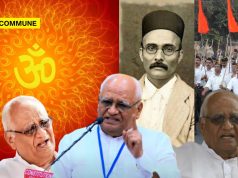
Prolegomenon
Quite often we come across a sordid spectacle wherein credit for some major, magnificent achievement is surreptitiously misappropriated. While the prime personality is pushed to the postern or even purged completely, a piddling character who pitches in at the postliminary stage and performs a petty task is prominently projected as though he is the principal player of the project. For instance, we have thousands of majestic temples with magnificent architecture throughout our nation. Seldom can we find the name of the king or the patron who had conceived, created and commissioned them for the common welfare of all. Take the case of the marvellous Brihadeeswara Temple at Thanjavur. Emperor Rajarajan has chosen to engrave the names of all the workers who toiled for its completion but has scrupulously avoided his own name. We learn from the inscription at the temple that the chief sculptor was one Kunjaramallan. Imagine a situation wherein, taking advantage of this fact, the descendants of that sculptor today start claiming that it was Kunjaramallan who built the temple, and not the emperor, how ridiculous will it be?
Now, here is the genesis of Mullai Periar dam with full details from the start. A discerning reader himself can diagnose, determine and derive his own dispassionate assessment as to how much of credit is due to each of the dramatis personae.
Prologue
Our story starts from the 17th century scenario when Velu Nachiar was defeated and Marudu brothers who were ruling Sivaganga principality. One Muthuramalinga Sethupathy was at the helm of Ramanathapuram. The Sethupathis, a native of the Ramanathapuram and Sivaganga district of Tamil Nadu, India, were a courageous and chivalrous clan belonging to Maravar community and were ruling Ramanathapuram since 17th century, under the suzerainty of the British through the agency of Arcot Nawab.
Muthuramalinga Sethupathy [1760-1809] was anointed when he was a child of just 27 days old. His mother acted as the regent during his infancy. They were ably assisted by one diligent and dynamic minister, Thalavai Muthu Irulappa Pillai. Muthuramalinga Sethupathy, being a strong-willed, daring leader, initially started resisting the dominance of the British and the Arcot Nawab. Sethupathy went to the extent of imposing tax on the goods of the British and of the Nawab. He was labelled as a rebel and was arrested at the early age of twelve along with his mother! Muthuramalinga Sethupathy and his mother were in prison for ten long years. Since there was public revolt against their detention which the rulers could not contain any longer, they were released.
Equipped with miniscule military resources vis-s-vis the monstrous might of the British army, Muthuramalinga Sethupathy adroitly avoided any impulsive confrontation and managed his domain admirably for some time. After keeping quiet for a while, he again attempted to impose tax on the goods of the British and the Nawab, since, as a responsible ruler, he wanted to protect his subjects during a famine and also for meeting the cost of construction of a dam which he had planned to build for the water requirement of his domain. The British got enraged and attacked him in 1795 alleging that he had a “disposition to rebel against the Government”, imprisoned him in Trichy jail and later shifted to Fort St. George, Chennai, where he died in 1809.
The Project
As regards the water resources of his kingdom, during the earlier Pandiya dynasty, the river Vaigai was flowing in full current and was providing abundant water for all their needs. Once the Pandiya dynasty declined, Nayakkars, who were deputies of Krishnadevarayar of Vijayanagaram took over while the Cheras were powerfully reigning in the south. The Cheras craftily and covertly converted the direction of the rivulets that were dispensing water to Vaigai and diverted their flow towards Kerala. As a result, Vaigai dried up and the eastern areas were experiencing a famine-like situation. Unable to endure the agony of his subjects, Muthuramalinga Sethupathy ordered his minister Muthu Irulappa Pillai to proceed to the source of water, explore the reason and take immediate remedial steps at all costs. Thus, the first seed for the dam was laid as early as 1792.
Accordingly, Muthu Irulappa Pillai travelled towards the origin of Vaigai on the mountainous region for investigation and in the process discovered many facts. A river by name Periar was flowing towards the west with five streamlets for 56 kms after which another brook by name Mullai joined the main river. Pillai conceived the idea that the direction of this Mullai can be reversed towards east by constructing a dam to ensure perennial water for Vaigai river. He submitted a detailed proposal with all technical data to the chieftain who instantly agreed and asked Pillai to proceed further for its implementation.
The Pitfall And Progress
But, there were two hurdles. First: The finance. Muthuramalinga Sethupathy insisted that the exaction levy being paid by the dominion to the British ruler should be utilised for the welfare of his people and therefore, the cost should be met from that fund. Second: As there was famine, the British ruthlessly exploited the opportunity by selling their produce to the locals at exorbitant rates. The levy being paid was also steeply enhanced to meet the expenditure for the war with Napoleon in Europe. Muthuramalinga Sethupathy objected to this and threatened that he will not pay the levy and instead, he will tax the goods being sold by the British. He was arrested and he breathed his last in prison at the age of 48. Thus the project had to be shelved temporarily thanks to the non-cooperation of the British.
The British coronated Mangaleshwari Nachiar, the elder sister of Muthuramalinga Sethupathy. A century passed. The grandson of M.R.Sethupathy, Vijayaraghunatha Bhaskara Sethupathy, ascended the throne in 1888. He was agile and assiduous, erudite and energetic. He took a resolve to realise the dream of his great grandfather and Muthu Irulappa Pillai. Since his province continued to be under the British dominion, he requested for their permission to go ahead. Initially they refused since inherently they were not interested in the welfare of the people. But, at that period, the clamour for freedom had started and the British could not resist the pressure for long. After some dilly-dallying they gave just the permission alone and not the money. Since the location of the proposed dam was in the princely state of Travancore, the British arranged for an agreement with the Travancore Samasthanam. A lease agreement for 999 years for 8000 acres of land was signed at the rate of ₹5/- per acre. While the British assisted for execution of the agreement, they did not pay a single rupee. The entire amount was paid only by Bhaskara Sethupathy. For further funds, he had to perforce mortgage all the resources of the kingdom for a sum of 20 lacs, with moneylenders, who were then functioning as benamis for the British. The construction commenced and was in progress.
As the cost of construction was colossal and as the British Government did not show any lenience, the loan of 20 lacs taken in 1893 swelled further and since Bhaskara Sethupathy could not repay, he became a bankrupt in 1894. All his properties were auctioned in 1895. With his dream of the dam decimated into dust, death devoured him at the prime age of 35.
The Completion
The distressing fact that the dam remained unbuilt reached the British Parliament. Disturbing questions were raised and to save their face, the British sent an engineer to complete the dam. His name was Pennycuick. He entered the scene in the typical fashion like the police force entering the climax scene in a film, after the hero had suffered lot of blows from the villains! His initial attempt was also not successful. He then felt that if he failed in the task, he might face insult, indignity and ignominy. Therefore he spent some of his own money, toiled on the project with total commitment and ensured its successful execution. A keen observer can notice lot of similarities between this episode and the Tamil film, ‘Linga’.
Epilogue
Now, let us look at an analogy: In a relay race all the four participants of the winning team are felicitated with the prize cup at the podium, not just the last runner of the team. In fact, the fourth runner could reach the winning post only thanks to the energetic efforts of the previous three who had ensured that the fourth fellow is provided with a comfortable lead for reaching the winning line. Let us look at another example. In cricket, when the morale of the team is at its lowest ebb, when it is losing every match and when the players are completely browbeaten, a strong captain emerges, wears the albatross of leadership, injects confidence, identifies the innate talent in each player and motivates them in such a manner that the team slowly starts performing better and winning matches. The baton of leadership now passes on to a new head when the team is on its top form and he is able to do a spectacular job nonchalantly. People start looking at the statistics alone and erroneously eulogise the new captain in extraordinary terms, completely forgetting the spade work done by the previous leader.
We hasten to add here that we do not dispute nor belittle the role played and the contribution provided by John Pennycuick in the successful culmination of the project. Not at all. Of course, he definitely deserves a part of the credit, but it can be at the most 25% and the balance, distributed among the earlier three, viz., Muthuramalinga Sethupathy, Muthu Irulappa Pillai and Muthu Vijayaraghunatha Bhaskara Sethupathy, is it not? Neglecting the earlier architects in toto, focussing on and extolling only that foreigner who came at the last stage, is deplorable and such a stance betrays our stupidity as well as our sordid and servile mentality. It is a pity that even after seven decades we have still not jettisoned our inferiority complex. Or, is it a deeper conspiracy by the communist chroniclers in camouflaging and completely concealing any credit legitimately due to local native leaders?
Click here to subscribe to The Commune on Telegram and get the best stories of the day delivered to you personally.




